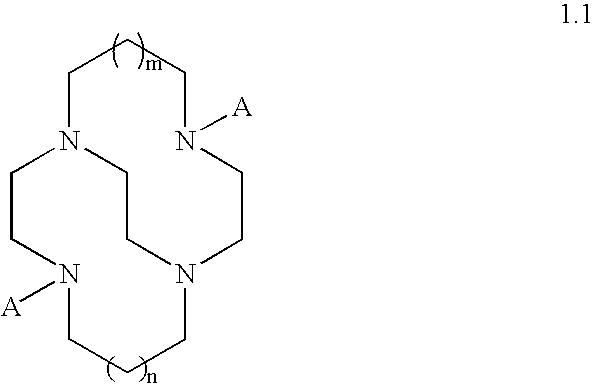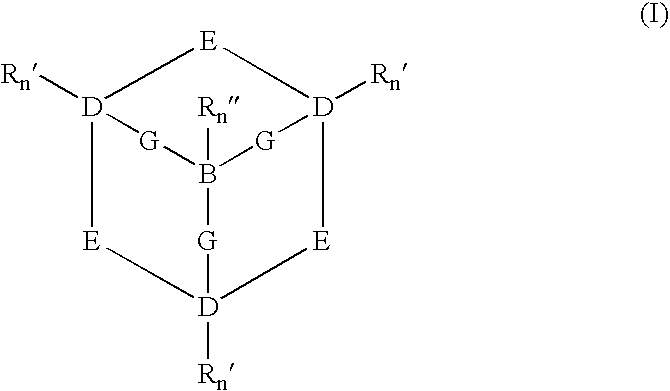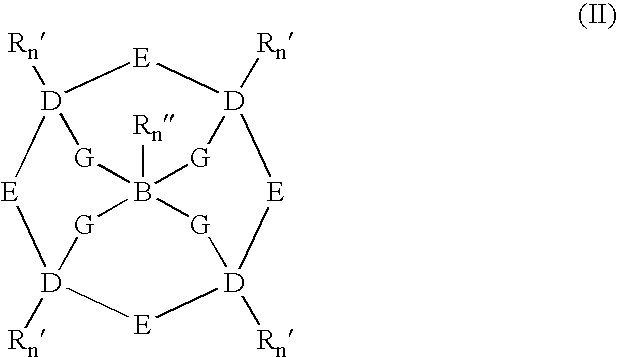Catalysts and methods for catalytic oxidation
a catalytic oxidation and catalyst technology, applied in the field of catalytic systems, can solve problems such as inability to purify
- Summary
- Abstract
- Description
- Claims
- Application Information
AI Technical Summary
Benefits of technology
Problems solved by technology
Method used
Image
Examples
example 1
Synthesis of [Mn(Bcyclam)Cl2]
[0235]
(a) Method I.
[0236]“Bcyclam” (5,12-dimethyl-1,5,8,12-tetraaza-bicyclo[6.6.2]hexadecane) is prepared by a synthesis method described by G. R. Weisman, et al., J. Amer. Chem. Soc., (1990), 112, 8604. Bcyclam (1.00 g., 3.93 mmol) is dissolved in dry CH3CN (35 mL, distilled from CaH2). The solution is then evacuated at 15 mm until the CH3CN begins to boil. The flask is then brought to atmospheric pressure with Ar. This degassing procedure is repeated 4 times. Mn(pyridine)2Cl2 (1.12 g., 3.93 mmol), synthesized according to the literature procedure of H. T. Witteveen et al., J. Inorg. Nucl. Chem., (1974), 36, 1535, is added under Ar. The cloudy reaction solution slowly begins to darken. After stirring overnight at room temperature, the reaction solution becomes dark brown with suspended fine particulates. The reaction solution is filtered with a 0.2μ filter. The filtrate is a light tan color. This filtrate is evaporated to dryness using a rotoevaporato...
example 2
Synthesis of [Mn(C4-Bcyclam)Cl2] where C4-Bcyclam=5-n-butyl-12-methyl-1,5,8,12-tetraaza-bicyclo[6.6.2]hexadecane
[0239]
(a)C4-Bcyclam Synthesis
Tetracyclic adduct I is prepared by the literature method of H. Yamamoto and K. Maruoka, J. Amer. Chem. Soc., (1981), 103, 4194. 1 (3.00 g., 13.5 mmol) is dissolved in dry CH3CN (50 mL, distilled from CaH2). 1-Iodobutane (24.84 g., 135 mmol) is added to the stirred solution under Ar. The solution is stirred at room temperature for 5 days. 4-Iodobutane (12.42 g., 67.5 mmol) is added and the solution is stirred an additional 5 days at RT. Under these conditions, I is fully mono-alkylated with 1-iodobutane as shown by 13C-NMR. Methyl iodide (26.5 g, 187 mmol) is added and the solution is stirred at room temperature for an additional 5 days. The reaction is filtered using Whatman #4 paper and vacuum filtration. A white solid, II, is collected (6.05 g., 82%).
[0240]13C NMR (CDCl3) 16.3, 21.3, 21.6, 22.5, 25.8, 49.2, 49.4, 50.1, 51.4, 52.6, 53.9...
example 3
Synthesis of [Mn(Bz-Bcyclam)Cl2] where Bz-Bcyclam=5-benzyl-12-methyl-1,5,8,12-tetraaza-bicyclo[6.6.2]hexadecane
[0243]
(a) Bz-Bcyclam Synthesis
[0244] This ligand is synthesized similarly to the C4-Bcyclam synthesis described above in Example 2(a) except that benzyl bromide is used in place of the 1-iodobutane.
[0245]13C NMR (CDCl3) 27.6, 28.4, 43.0, 52.1, 52.2, 54.4, 55.6, 56.4, 56.5, 56.9, 57.3, 57.8, 60.2, 60.3, 126.7, 128.0, 129.1, 141.0 ppm. Mass Spec. (MH+, 331).
(b) [Mn(Bz-Bcyclam)Cl2] Synthesis
[0246] This complex is made similarly to the [Mn(C4-Bcyclam)Cl2] synthesis described above in Example 2(b) except that Bz-Bcyclam is used in place of the C4-Bcyclam. Ion Spray Mass Spectroscopy shows one major peak at 430 mu corresponding to [Mn(Bz-Bcyclam)(formate)]+.
PUM
| Property | Measurement | Unit |
|---|---|---|
| bond angle | aaaaa | aaaaa |
| bond angle | aaaaa | aaaaa |
| angle | aaaaa | aaaaa |
Abstract
Description
Claims
Application Information
 Login to View More
Login to View More - R&D
- Intellectual Property
- Life Sciences
- Materials
- Tech Scout
- Unparalleled Data Quality
- Higher Quality Content
- 60% Fewer Hallucinations
Browse by: Latest US Patents, China's latest patents, Technical Efficacy Thesaurus, Application Domain, Technology Topic, Popular Technical Reports.
© 2025 PatSnap. All rights reserved.Legal|Privacy policy|Modern Slavery Act Transparency Statement|Sitemap|About US| Contact US: help@patsnap.com



